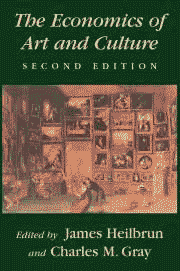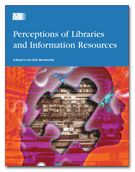
This disconnectedness is parallel in terms of the divisions we usually employ relative to human intelligence abilities and spheres of knowledge, like when we draw distinctions between the arts and sciences. Such distinctions, given our adoption and success of the economic model of division of labor and our compartmentalized education system, have become well established in our society and way of thinking. However, there are historical figures we can easily think of who were all-embracing of both the arts and sciences in their way of thinking, e.g. Da Vinci, Benjamin Franklin, Omar Khayyam, and Hildegard of Bingen. And libraries, intriguingly enough, are places where anyone can find information on the arts and sciences all under one roof.
The arts however, represent one aspect of human activity which, while generally generating much admiration, tends to garner relatively less respect and is seen to be of relatively lesser importance than the sciences. This becomes apparent moreso in hard economic times when arts programs in our schools or funding for city or state arts institutions are typically the ones that are first cut.
As such, given the country’s current economic situation and the still tremulous atmosphere on Wall Street, it seems appropriate or preemptive to highlight the role of the arts in our society and the library institutions that support and help preserve the work of artists and artistes for our current benefit and for posterity. Moreover too, when we usually think of libraries, typically we tend to think of book holdings as opposed to holdings of art pieces and recorded performances, which presents all the more reason why the work of art libraries seems one to be highlighted.
The arts tend to be looked at with less regard too given that they do not lend themselves readily to measurement. We live in a quantitative world where we like to account for everything empirically and the less structured, ethereal and abstract nature of the arts are opposite to the concreteness and certainty that we seek and like to rely upon for the results-oriented, fast-paced world we live in. But perhaps it is a consequence that given the very nature of the abstractness and immeasurability of the arts, it is why we are at times rendered speechless upon viewing some beautiful or intriguing work of art or when we are among the audience of some rhapsodizing performance artiste, we struggle for words to measure and account for how such art has affected us.
Nevertheless, measure we must, and one way we can measure the impact of the arts upon us is via the economy. One relatively new aspect of our economic thinking has been to greater appreciate and incorporate the very bedrock and ethos of the arts i.e. creativity. This has given rise to terms such as, the creative economy, creative industries and the creative class. In a 2005 article “States and the Creative Economy” on the National Assembly of State Art Agencies (NASAA) Web site, it states:
"Many states have measured the economic effects of the creative sector, which nationwide amounts to billions of dollars through direct spending by cultural organizations and related spending by consumers. Creative enterprises are also key employers in some regions and produce billions of dollars in local, state and federal taxes each year."
To fuller expound upon the economic contribution of the arts, here are some other salient facts and figures about the arts and the economy that the NASAA has listed on its Creative Economy Resource Center Web page:
America's nonprofit arts industry generates $166.2 billion in economic activity every year, resulting in $29.6 billion in federal, state, and local tax revenues.Source: Americans for the Arts, Arts & Economic Prosperity III: The Economic Impact of Nonprofit Arts and Culture Organizations and Their Audiences, 2007.
The creative sector, whose economic function is to create new ideas or creative content, employs 38 million Americans, or 30 percent of all employed people. Source: Richard Florida, The Rise of the Creative Class, 2002.
In 2006, 574,596 U.S. businesses participated in the production or distribution of art and employed nearly 3 million people. Source: Americans for the Arts, Creative Industries Report, 2006.
The arts, nonetheless, represent more than just money and employment for the economy. The arts, according to Dana Gioia, Chairman of the National Endownment for the Arts (NEA), provide us with a means to celebrate, commemorate, perform and meditate. Gioia shared this and other views on the arts in an interview with NASAA CEO Jonathan Katz. Further in the interview, Gioia in describing the arts, sees them not as a luxury but an:
"essential part of a full education and healthy society" and as "an essential component of a free society and democracy."
Gioia goes on to highlight three areas for the arts to regain a more central role in our society:
Bring coverage back into the media.
Rebuild the arts position in public education.
Create and build public consensus about the necessity for public support for the arts.
There are many libraries and and their umbrella library associations which all do tremendous work in the promotion and conservation of the arts. Some of the major library associations include:
TLA - Theatre Library Association
These organizations along with arts institutions and book authors (see listing below) writing on such topics as creativity, creative arts, and the creative economy all remind us that it is creativity, that is truly the hallmark of humankind and is what is effectively placed at stake when we let the arts flounder.
Short List of Books on Creativity, Performance Arts, and Art Librarianship

Handbook of Creativity, Robert J. Sternberg (Editor)
Cambridge University Press, 1998

The Economics of Art and Culture,
James Heilbrun, Charles M. Gray, Cambridge University Press 2001

The Rise of the Creative Class: And How It's Transforming Work, Leisure, Community and Everyday Life, Richard Florida, Basic Books 2003

The Arts of Democracy: Art, Public Culture, and the State (The Arts and Intellectual Life in Modern America),
Casey Nelson Blake, University of Pennsylvania Press, 2007
Music Library and Research Skills,
Jane Gottlieb, Prentice Hall 2008

Art Museum Libraries and Librarianship, Joan M. Benedetti, The Scarecrow Press Inc. 2007


















